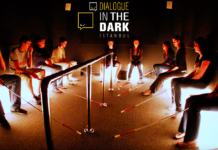Combining works by 27 local and globally based artists in an exhibition called Locus Solus, Selen Ansen has curated a collection that explores the ideas of nature and humanity, and their intersection. Portraying the grandiosity and complexity of nature, the exhibition includes large scale installations as well as abstract and site-specific new productions. The exhibition will be on display in Galleries 3 and 4 of Arter until Saturday, 31st of December. More information and tickets available via the exhibition page.
From the organizers:
The exhibition Locus Solus takes the idea of “nature” as its centre with the aim of exploring its facets through the lens of facts, fictions and emotions. The exhibition is concerned with the ways in which nature and culture permeate and affect each other; how organic processes and natural environments intersect with human agency and edifices. In the exhibition, “nature” stands primarily as a relational notion which enables to rethink the vast array of connections between places, non-human and human beings. It unfolds as a multi-layered construct which is shaped by shared narratives, rituals, elements from the collective unconscious, and individual experiences; and which in return, mirrors human fears and desires. Addressing our contrasted relationship with the places, beings and processes we generally refer to as “nature”, the works on display stage the reciprocal interplay between heterogeneous realms and formulate a network whose constituents, whether material or not, interconnect. Here, past mirrors future, fantasy encapsulates reality, the physical bonds with the metaphysical, the visible echoes the invisible, that which exists conveys the memory of that which is gone and foreshadows what is yet to come. Above all, the exhibition is grounded in the realisation that nature isn’t merely a catalogue of things and beings that exist, grow, and perish outside of us, and the conviction that the natural character of nature can no longer be taken for granted.
Locus Solus is conceived at once as a place and a journey. It brings together selected works from the Arter Collection with several large-scale installations, including site-specific new productions. The title of the exhibition, meaning “solitary place” or “unique place” in Latin, is borrowed from the novel with the same name by Raymond Roussel which takes the reader on a stroll among eerie man-made inventions and marvellous artefacts installed in the park of a villa. Alluding to the theatrical universe of Roussel’s novel, the title Locus Solus sheds light on the spatial emphasis of the exhibition while opening up a territory in which images and symbols travel beyond physical borders.
Locus Solus is a solitary place, provided that no place is uninhabited, and no island is deserted. In other words, this place is solitary in a deceptive sense. It is populated with plenty of realms and territories of various scales, since a single place would not suffice to contain the many solitudes. Each exhibited work presents a world in its own right, in which the natural and the artificial don’t merely cohabitate; they also mingle and collide. Visitors who step into the exhibition may find themselves wandering among extinct territories, subconscious landscapes, foreign lands, fictive rooms, heres, elsewheres and nowheres, wonderlands, heavenly, earthly and subterranean realms, and places that cities hardly provide – mountains, forests, islands, deserts, and even paradises. While journeying among these existing or imagined, physical or mental spaces, they may eventually sense that they are walking in the footsteps of past lives, inherited practices, perpetuated images and discourses.
Referencing the idea of “nature”, these works position us at a crossroads between human and non-human realms, while allowing us to experience space and geography from an affective perspective. On the basis that nature and culture are far from being mutually exclusive categories, they are keen on breaking with the fixity of established categories. At the same time, however, they refrain from casting aside the deep-rooted dichotomies that have been established throughout history. Rather, they turn these dichotomies into an active struggle which generates novel forms and brings forth new connections. In so doing, they offer the possibility to problematise, expand, renew the relationships between mineral, vegetable, animal and human existences; and disclose non-linear kinships between inert things and sentient beings. Articulating darkness and light, growth and decay, oblivion and remembrance, tragedy and wonder, the journey provides us with a circular itinerary reminiscent of the cyclical iterative structure of myths and tales. Should this journey without a destination have an aim, it would intend to liberate imagination from subordination to the linear, progress-driven course of contemporary societies.
—
Image sourced via the organizers.
More information available through the exhibition page.
Yenişehir, Irmak Cd. No:13, 34435 Beyoğlu/İstanbul










